Four years after the Great East Japan Earthquake, the Third UN World Conference on Disaster Risk Reduction was held in Sendai, Miyagi prefecture, from March 14 to 18. The conference has been organized by the United Nations and consecutively held in Japan to discuss an international strategy on Disaster Risk Reduction (DRR). It was first held in Yokohama in 1994, and held for the second time in Hyogo in 2005, and this time in Sendai. The objective of the third conference was to formulate a successor framework to the Hyogo Framework for Action (HFA), which was adopted during the Second conference in 2005.
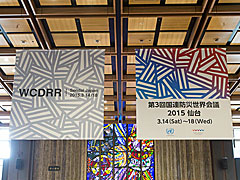
Sendai Station receives people involved in disaster risk reduction from around the world.
Taking on frequently occurring natural disasters through international coordination
In recent years, natural disasters have tended to occur more frequently and to become larger in scale because of climate change and other factors. According to a report by the United Nations secretariat of International Strategy for Disaster Reduction (UNISDR), 1 million people have been killed, 3 billion people have been affected and total damage of more than 170 trillion yen has been caused by natural disasters in the world since 2000. In particular, developing countries have been seriously affected because of vulnerability in social infrastructure. Victims by natural disaster in those countries account for 90 percent of the world's total and natural disasters are obstructing economic growth in them.
In 1990, the international community started the International Decade for Natural Disaster Reduction (IDNDR) with the aim of reducing damage caused by natural disasters, and the U.N. has been taking on disaster risk reduction and mitigation internationally. In 2005, the current guideline, the Hyogo Framework for Action (HFA), was adopted at the conference. The HFA is a strategy for DRR activities the international community aimed to achieve in 10 years. The prioritized action plan was formulated with strategic aims including i) inclusion of the point of view of DRR into sustainable development, ii) improvement of DRR capacity by establishing disaster management system on every level, especially on the local community level, and iii) introduction of a method of preparedness for response and recovery and reconstruction.
Under these circumstances, Japan has been presenting knowledge and lessons on DRR as a country often affected by earthquakes, tsunamis, typhoons, flooding, volcanic eruptions and other kinds of natural disasters, and Japan has been leading discussions at the U.N. conferences on DRR based on its experiences.
In light of Japan's experiences after the Great Hanshin-Awaji Earthquake that occurred in 1995, the Disaster Reduction Learning Center (DRLC) was founded within JICA Kansai in 2007, with the cooperation of Hyogo prefecture. In DRLC, training programs for administrative personnel from developing countries have been organized, more than 2,000 people from 100 countries have been participating (as of end of December 2014), and they have been taught lessons from the the Great Hanshin-Awaji Earthquake and other severe disasters.
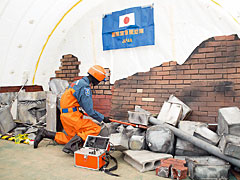
A booth of the Secretariat of Japan Disaster Relief Team at the exhibition event, in Kotodai Park. Events and exhibitions related to DRR were organized in several places in Sendai.
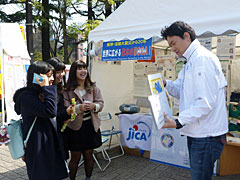
At a booth of JICA Kansai in Kotodai Park.
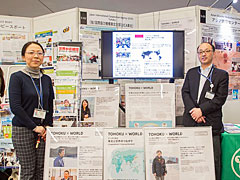
At a booth of JICA Tohoku in Sendai Mediatheque.
To build a disaster resilient society
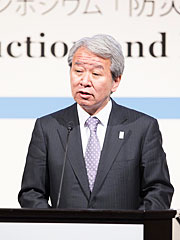
JICA President Akihiko Tanaka
In conjunction with the opening day of the U.N. Conference on Disaster Risk Reduction, the Japan International Cooperation Agency (JICA) organized a symposium entitled “Disaster Risk Reduction and International Cooperation” at the Hotel Metropolitan Sendai, to discuss the direction of DRR policy in each country and the appropriate state of international cooperation.
JICA’s President Akihiko Tanaka delivered a keynote speech and mentioned considerable support from more than 100 countries and regions during the Great East Japan Earthquake.
“I confirmed my feeling that the world is interdependent. We should incorporate what we learned from the assistance of each country into the post Hyogo Framework for Action,” Tanaka said, and he talked about Japan’s determination to contribute to the international strategy on disaster prevention. He named “Disaster Risk Reduction” and “Mainstreaming DRR” as concrete challenges.
In recent years, increasingly severe natural disasters have become a threat to even developed countries. Tanaka pointed out that disasters are obstacles to achieving sustainable development and they are a factor aggravating poverty, particularly in developing countries.
“International cooperation related with natural disasters has been focused on post-disaster interventions, such as reconstruction and rehabilitation efforts. We have to increase prior investment in DRR measures to build a more disaster resilient society. Japan has faced the threat of natural disasters and has heavily invested in prevention. 'Mainstreaming DRR,' which includes viewpoint of DRR in all sectors related to socio-economic development, has supported Japan's economic development. 'Mainstreaming DRR' is necessary for the realization of sustainable development and a disaster-resilient society,” he emphasized.
The importance of pre-investment for DRR
A panel discussion followed and leaders from countries with close relations with Japan and members of international organizations discussed the direction of international DRR policy. Six people took the platform: Rachel Kyte, World Bank vice president, Helen Clark, administrator of the United Nations Development Programme (UNDP), Kristalina Georgieva, vice president of the European Commission, Gerson Martinez, minister of Public Works, Transportation, Housing and Urban Development of El Salvador, Rogelio Singson, minister of Public Works and Highways of the Philippines, and Akihiko Tanaka, president of JICA.
Panelists discussed i) prior investment in DRR, ii) efforts on capacity development of central government, iii) the concept of “Build Back Better,” which conceives of reconstruction as an opportunity for building a disaster-resilient society, iv) mainstreaming DRR and v) international cooperation. While each country pronounced opinions based on its experiences, they agreed on the importance of fully understanding the risk of natural disasters to advance prior investment for DRR, and also on thinking from the point of view of women and socially vulnerable people including children, the elderly, and people with disabilities. The “Build Back Better” concept got the attention of participants.
El Salvador and the Philippines are countries similar to Japan in that natural disasters occur frequently and are national concerns. Leveraging Japan’s knowledge and experiences, JICA has been extended cooperation in DRR in both countries. The Philippines was greatly affected by Typhoon Yolanda in November 2013, and reconstruction has been carried out with the aim of building a disaster-resilient society, based on the strategy of “Build Back Better”. “JICA has been cooperating seamlessly since immediately after the occurrence of the disaster, including providing emergency assistance, support for recovery and reconstruction, and subsequent technical and financial cooperation,” said Tanaka, explaining examples of JICA’s cooperation in DRR.
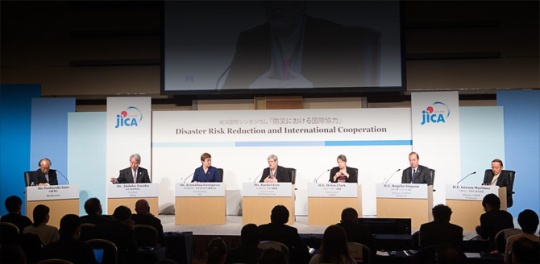
From left, Toshiyuki Sato, secretary general of the Public Broadcasters International, who acted as a facilitator, Akihiko Tanaka, president of JICA, Kristalina Georgieva, vice-president of the European Commission, Rachel Kyte, vice president of the World Bank Group, Helen Clark, administrator of UNDP, Rogelio Singson, minister of Public Works and Highways of the Philippines, and Gerson Martinez, minister of Public Works, Transportation, Housing and Urban Development of El Salvador.
Promotion of a society of gender equality and fostering women leaders in DRR
On March 18, a public forum entitled “Women as a Force for Change — Gender Equality and Disaster Risk Reduction” was organized by the Japan Women’s Network for Disaster Risk Reduction and the Japan Association for Women’s Education, to consider gender equality and nurturing women’s leadership and for the realization of a disaster resilient society. During the Great East Japan Earthquake, many of temporary shelters were managed by men, which caused lack of consideration for women. And also socially vulnerable people had to stay in inconvenient situations. Similar cases have occurred in other affected countries. Discussion focused on i) emergency responses in which diverse needs and the needs of women are reflected, ii) the importance of fostering women’s leadership in disaster response, iii) the participation of women in decision of policies and planning in DRR, iv) the arrangement of statistics and indicators in gender and vi) future actions.
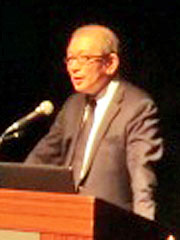
JICA’s Senior Vice-President Hideaki Domichi
JICA’s Senior Vice-President Hideaki Domichi delivered his speech at the forum and explained that JICA also will conduct support in DRR from the viewpoints of gender equality and diversity, and will begin a training program to reinforce the participation and leadership of women in DRR.
Toward sustainable development through disaster risk reduction
Some 6,500 people including representatives of 187 U.N. member countries, U.N. organization, donors and NGOs participated in the five-day conference. The progress of the Hyogo Framework for Action (HFA) formed at the last conference was confirmed and assessed, and a successor framework to be adopted at this conference was discussed.
On March 18, on the last day of the five-day event, the “Sendai Framework for Disaster Risk Reduction 2015-2030” was adopted. Under this framework, the promotion of understanding of disaster risk, strengthening of the disaster risk governance to manage disaster risk, prior investment in DRR for resilience, and the promotion of “Build Back Better” will be advanced as priorities for action. Roles in DRR were described not only for government, but also the private sector, academic, science and research organizations, civil society and mass media.
During the conference, JICA signed a Memorandum of Cooperation (MOC) with UNISDR. JICA and UNISDR came to an agreement over mutual cooperation for the promotion of i) prior investment in DRR, ii) prompting capacity development and knowledge on DRR in developing countries and iii) “Build Back Better,” together with the implementation of the newly adopted “Sendai Framework of Disaster Risk Reduction 2015-2030.” Based on the MOC, JICA will continue making efforts on further developing the mainstreaming DRR in developing countries and conducting cooperation in DRR sector.
Related Link
- President Tanaka’s keynote speech on March 14




scroll